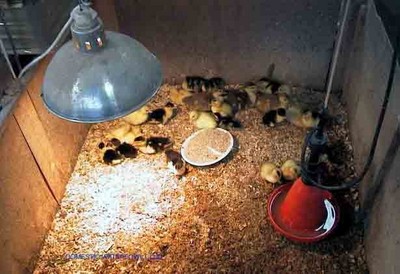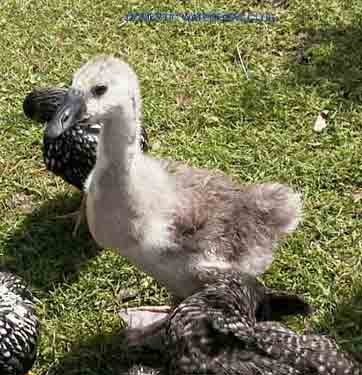<!--<!--<!--<!--
Rearing Ducks
Raising ducks is virtually foolproof provided they are kept warm, dry and well fed, ducklings almost rear themselves.
Brooding For a few weeks after hatching, all young birds require to be kept warm. Normally this is done by the mother but, when rearing artificially, we need a source of warmth. Fortunately young waterfowl can walk and feed themselves within a few hours of breaking out of the egg, so their care is very simple. Once your ducklings have hatched, leave them in the incubator for a couple of hours to dry off and then transfer them to a brooding pen or hutch. The simplest arrangement is a small rectangle with wooden walls laid over newspaper on the floor of a garage or shed. The walls need only be twelve inches high and a wire mesh top will prevent the little birds jumping out (very necessary for Muscovy or wildfowl...they climb !) .As mentioned previously, a source of heat must be provided. For most ducklings, an ordinary 60 or 100-watt light bulb will be perfectly adequate for up to 40 ducklings. Use additional bulbs for extra units of 20 birds. Begin with the bulb positioned about seven inches from the floor and adjust the height by observing the behavior of the ducklings. If they huddle together beneath the bulb, it requires to be lowered while, on the other hand, if they stay at the perimeter of their pen, the bulb needs to be raised. Keep the bulb on constantly for the first two weeks, raising it an inch every three days. During week three, turn it off for an hour on day one, two hours on day two and so on and then, at the start of the fourth week, provide heat only during the hours of darkness. If weather conditions are normal for the time of year, you should be able to dispense with artificial heat by the end of that week. After a week indoors without heat, the young birds can be transferred to an outdoor pen which is best constructed with wire mesh in a suitable corner of the garden. Do, however, provide a hutch or covered area so that the birds can obtain shelter from heavy rain.

Food and Drink
Feeding ducklings presents no problems at all. For the first four weeks, feed them on ordinary chick crumbs which you can buy in small quantities from any good pet shop. Ducklings will eat those crumbs immediately upon hatching. From four weeks of age until feathering, the young birds should be fed grower's pellets which, once again, can be obtained from a pet shop or agricultural supplier. At all stages, simply feed ad-lib, leaving a constant supply of food with the birds and allowing them to eat as much and as often as they want. Sometimes they appreciate a few greens to augment their diet and the easy way of providing these is to hang a lettuce in their pen for them to peck at. Clean water must be available constantly but it must be provided in a manner which prevents the little birds taking a bath in it. Although day old ducklings will swim in the wild, they are able to do this because they are waterproofed by a film of oil which they get from their mother's plumage. Your hand-reared ducklings will not have this protection and will chill if they become wet. The best type of drinker is the inverted jam jar model which suppliers like Eltex can provide very cheaply. A larger model will be useful after the first week or so but be sure to put some small stones around the exposed area so that the birds cannot clamber in for a swim!
Eventually, at the age of seven or eight weeks, the day will come when you can release your birds into the garden. Ducklings can go straight out to a suitable pond and see how much truth they give to the phrase "taking like a duck to water". Provided there is sufficient plant life in the pond (to harbour insects), you need only scatter a few scoops of food around the margins to supplement the natural feeding which will be available. It is wise to avoid hand-feeding duck any more than is absolutely necessary as they tend to become over-tame and fall east prey to predators.. Looking after those birds over the spring and summer takes very little time and effort. Memo for the lazy a Childs fishing net collects fast running ducklings easier than crawling through the shrubs.

There are many reasons for keeping geese. They will eat slugs and snails, and the geese will control your overgrown grass.
Small group can be brooded by broody hens and most breeds of ducks other than Pekin and Runner. If they aren't hatched by the broody, place them under her at night so that she will accept them. Goslings can be brooded artificially in about the same way as chicks. Due to their rapid growth, they will need heat a shorter period of time, and floor space requirements will increase rapidly.
Starting the goslings is not difficult. Start with clean quarters. The environment should rodent free. For smaller numbers all you need is a large cardboard box, some shavings or hay, a heat lamp, a feeder and water. Any small building; garage or corner can be used as a brooding area for small numbers of birds. The brooding area should be dry, reasonably well lit and ventilated, and free from draughts. Cover the floor with a few inches of absorbent litter material, such as wood shavings, chopped straw, or peat moss. With a layer of paper sacks or newspaper underneath (helps on removal). Litter dampness and smell is more of a problem with waterfowl. Good management will require removal of wet spots and frequent addition of clean, dry litter.
When raising Muscovy ducklings and some ornamental geese, keep in mind that they are very good climbers. Make sure that they will not burn themselves in the heat source should they climb the sides. Or, escape over the top if using an open brooder.** old fridge shelves are excellent brooder lids**
BROODING;
Infrared heat lamps are a convenient source of heat for brooding small numbers of birds. The most commonly used brooder is the 4 bulb, 250 watt (heat bulb) brooder lamp. These lamps are adequate for 300 chicks. Use one 250-watt lamp for 30 goslings or alternatively a 60 watt ordinary light bulb for a few. Heat lamps provide radiant heat to the birds under them. Since the air isn't heated, room temperature measurement isn't as important. When using hover-type brooders, brood only a quarter as many goslings as chick capacity. Because goslings are larger than chicks in size, it may be necessary to raise 3 to 4 inches, higher yet for goslings. Have the temperature at the edge 85 to 90 degrees F when they arrive. Reduce it 5 to 10 degrees per week.
You will be able to tell on sight if the gosling are warm enough. If they are too hot, they will move away from the heat. If too cold they may pile up and be noisy. The birds will be moving around, eating and drinking if they are comfortable. High temperatures may result in slower feathering and growth. When decreasing the temperature consider the behavior of your goslings at all times.
As they grow, they will need more space and less heat. Observe the birds - if they stay away from the heat, turn it off - if they get their pen messy rapidly, they need more bedding and more space. Supplementary heat may be needed for 5 to 6 weeks in cold weather; in summer, only 2 to 3 weeks. By five or six weeks they can probably be outside all the time, except in extremely cold, wet weather. Make sure it's good weather before you put them outsid
This requires a dry duckling preferably before breakfast/good light or a lamp/short fingernails and patience to learn. Try once mark the duckling and when the males voice drops then check your success rate. Contrary to opinion ducks and geese can be sexed at any age . Chickens must be vent sexed at under 24 hours old with no food or water or their sex organs are hidden as they grow which is why feather sexing is now more common.



ساحة النقاش